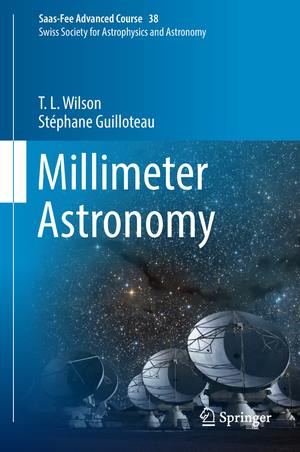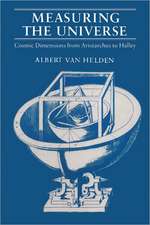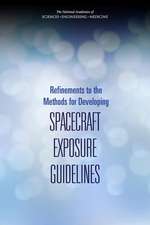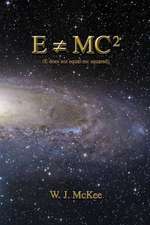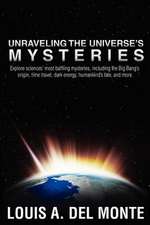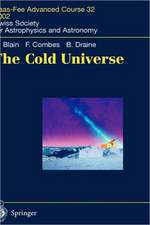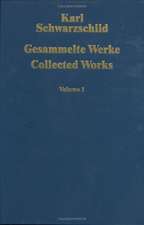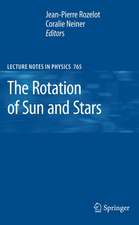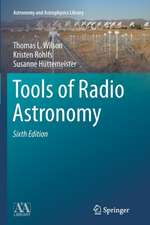Millimeter Astronomy: Saas-Fee Advanced Course 38. Swiss Society for Astrophysics and Astronomy: Saas-Fee Advanced Course, cartea 38
Autor T. L. Wilson, Stéphane Guilloteau Editat de Miroslava Dessauges-Zavadsky, Daniel Pfennigeren Limba Engleză Hardback – 18 iul 2018
This book is based on and extensively updated from the lectures given during the Saas-Fee Advanced Course 38 on millimeter astronomy. It presents both the observing techniques and the scientific perspectives of observations at millimeter wavelengths, here in particular the star and planet formation.
The chapters by Thomas L. Wilson and Stéphane Guilloteau have been edited by Miroslava Dessauges-Zavadsky and Daniel Pfenniger. The book is part of the series of Saas-Fee Advanced Courses published since 1971. The targeted audience are graduatePhD and advanced undergraduate students, but the book also serves as reference for post-doctoral researchers or newcomers to the field.
| Toate formatele și edițiile | Preț | Express |
|---|---|---|
| Paperback (1) | 578.87 lei 6-8 săpt. | |
| Springer Berlin, Heidelberg – feb 2019 | 578.87 lei 6-8 săpt. | |
| Hardback (1) | 727.80 lei 6-8 săpt. | |
| Springer Berlin, Heidelberg – 18 iul 2018 | 727.80 lei 6-8 săpt. |
Din seria Saas-Fee Advanced Course
-
 Preț: 388.13 lei
Preț: 388.13 lei -
 Preț: 362.26 lei
Preț: 362.26 lei -
 Preț: 401.24 lei
Preț: 401.24 lei - 15%
 Preț: 656.74 lei
Preț: 656.74 lei - 15%
 Preț: 659.35 lei
Preț: 659.35 lei - 18%
 Preț: 898.26 lei
Preț: 898.26 lei - 15%
 Preț: 649.71 lei
Preț: 649.71 lei - 15%
 Preț: 653.00 lei
Preț: 653.00 lei - 15%
 Preț: 655.60 lei
Preț: 655.60 lei - 18%
 Preț: 896.52 lei
Preț: 896.52 lei - 15%
 Preț: 642.03 lei
Preț: 642.03 lei - 15%
 Preț: 647.59 lei
Preț: 647.59 lei - 15%
 Preț: 653.14 lei
Preț: 653.14 lei - 15%
 Preț: 647.92 lei
Preț: 647.92 lei - 15%
 Preț: 714.49 lei
Preț: 714.49 lei - 15%
 Preț: 651.51 lei
Preț: 651.51 lei - 15%
 Preț: 643.16 lei
Preț: 643.16 lei - 18%
 Preț: 1007.03 lei
Preț: 1007.03 lei -
 Preț: 392.37 lei
Preț: 392.37 lei -
 Preț: 452.25 lei
Preț: 452.25 lei -
 Preț: 392.75 lei
Preț: 392.75 lei -
 Preț: 400.10 lei
Preț: 400.10 lei - 18%
 Preț: 954.62 lei
Preț: 954.62 lei - 23%
 Preț: 638.76 lei
Preț: 638.76 lei - 15%
 Preț: 533.72 lei
Preț: 533.72 lei
Preț: 727.80 lei
Preț vechi: 887.55 lei
-18% Nou
Puncte Express: 1092
Preț estimativ în valută:
139.26€ • 145.40$ • 115.26£
139.26€ • 145.40$ • 115.26£
Carte tipărită la comandă
Livrare economică 04-18 aprilie
Preluare comenzi: 021 569.72.76
Specificații
ISBN-13: 9783662575451
ISBN-10: 3662575450
Pagini: 179
Ilustrații: VII, 183 p. 54 illus., 10 illus. in color.
Dimensiuni: 155 x 235 mm
Greutate: 0.45 kg
Ediția:1st ed. 2018
Editura: Springer Berlin, Heidelberg
Colecția Springer
Seria Saas-Fee Advanced Course
Locul publicării:Berlin, Heidelberg, Germany
ISBN-10: 3662575450
Pagini: 179
Ilustrații: VII, 183 p. 54 illus., 10 illus. in color.
Dimensiuni: 155 x 235 mm
Greutate: 0.45 kg
Ediția:1st ed. 2018
Editura: Springer Berlin, Heidelberg
Colecția Springer
Seria Saas-Fee Advanced Course
Locul publicării:Berlin, Heidelberg, Germany
Cuprins
Introduction to Millimeter/Sub-Millimeter Astronomy (T.L. Wilson).- 1 Introduction.- 2 Some Background.- 3 Theory of Receivers.- 4 Practical Receivers.- 5 Filled Aperture Antennas.- 6 Single Dish Observational Methods.- 7 Interferometers and Aperture Synthesis.- 8 Continuum Emission from mm/sub-mm Sources.- 9 Spectral Line Basics.- 10 Line Radiation from Atoms.- 11 Emission Nebulae, Radio Recombination Lines.- 12 Overview of Molecular Basics.- 13 Astronomical Applications.- References.- Star Formation with ALMA (S. Guilloteau).- 1 Introduction.- 2 Dust as a Probe of Star Formation.- 3 Using Molecules.- 4 Prestellar Cores.- 5 Class 0.- 6 Outflows.- 7 Protoplanetary Disks.- 8 High-Mass Stars.- 9 Nonstandard Observations.- 10 Conclusions: The promise of ALMA.- References
Notă biografică
About the Authors:
Thomas L. Wilson was on staff at Max-Planck-Inst. f. Radioastronomie from 1969-2004. During this time, he was sent to Arizona as Director of the Sub-mm Telescope Observatory (1997-2002). After this, he was Project Scientist (2004-6), Associate Director (2006-8) and at European Southern Observatory, and subsequently Senior Scientist at ALMA (Atacama Large Mm/sub-mm Array), from Feb 2009 to March 2010. From April 2010 to December 2015, he was at the Naval Research Laboratory, then the NSF Division of Astronomical Sciences, working in the Spectrum Management Unit. Since December 2017 he has an emeritus position with the Max-Planck-Institute for Radioastronomie in Bonn.
Stéphane Guilloteau is "Directeur de Recherche de classe exceptionnelle at CNRS" in Bordeaux. He graduated from the Ecole Normale Supérieure de Paris. He was recruited at CNRS in 1980, just after the creation of an Astrophysics Group at Université de Grenoble. In 1987, he became project scientist of the IRAM interferometer, and later, deputy director of IRAM. He worked on the conception and design of ALMA as Project Scientist between 1999 and 2003. He then joined the Université of Bordeaux. In 1989, he received the "Young Scientist" prize of the Société Française d’Astronomie et d'Astrophysique.
About the Editors:
Miroslava Dessauges-Zavadsky graduated in Physics from the University of Lausanne. She got her PhD in Astrophysics from the University of Geneva after having benefited from a two-years doctoral studentship at the European Southern Observatory in Munich. Then she came back to the Geneva Observatory as a post-doctoral fellow. Since 2010, she has there a permanent position as a scientific collaborator in the extragalactic group and as a local expert in millimeter wavelength observations.
Daniel Pfenniger is Professor of Extra-Galactic Astrophysics at Geneva Observatory, the Astronomy Department of University of Geneva. He studied Physics at University of Geneva, and Astronomy at Universities of Geneva and Hamburg. He obtained a PhD in Galactic Dynamics at Geneva Observatory in 1985, and subsequently a post-doctoral grant for a stay at the Institute for Advanced Study, Princeton, USA. His works bears on galactic dynamics in spiral and elliptical galaxies, cold hydrogen forms in the interstellar medium as dark matter component, and cosmological massive neutrinos.
Thomas L. Wilson was on staff at Max-Planck-Inst. f. Radioastronomie from 1969-2004. During this time, he was sent to Arizona as Director of the Sub-mm Telescope Observatory (1997-2002). After this, he was Project Scientist (2004-6), Associate Director (2006-8) and at European Southern Observatory, and subsequently Senior Scientist at ALMA (Atacama Large Mm/sub-mm Array), from Feb 2009 to March 2010. From April 2010 to December 2015, he was at the Naval Research Laboratory, then the NSF Division of Astronomical Sciences, working in the Spectrum Management Unit. Since December 2017 he has an emeritus position with the Max-Planck-Institute for Radioastronomie in Bonn.
Stéphane Guilloteau is "Directeur de Recherche de classe exceptionnelle at CNRS" in Bordeaux. He graduated from the Ecole Normale Supérieure de Paris. He was recruited at CNRS in 1980, just after the creation of an Astrophysics Group at Université de Grenoble. In 1987, he became project scientist of the IRAM interferometer, and later, deputy director of IRAM. He worked on the conception and design of ALMA as Project Scientist between 1999 and 2003. He then joined the Université of Bordeaux. In 1989, he received the "Young Scientist" prize of the Société Française d’Astronomie et d'Astrophysique.
About the Editors:
Miroslava Dessauges-Zavadsky graduated in Physics from the University of Lausanne. She got her PhD in Astrophysics from the University of Geneva after having benefited from a two-years doctoral studentship at the European Southern Observatory in Munich. Then she came back to the Geneva Observatory as a post-doctoral fellow. Since 2010, she has there a permanent position as a scientific collaborator in the extragalactic group and as a local expert in millimeter wavelength observations.
Daniel Pfenniger is Professor of Extra-Galactic Astrophysics at Geneva Observatory, the Astronomy Department of University of Geneva. He studied Physics at University of Geneva, and Astronomy at Universities of Geneva and Hamburg. He obtained a PhD in Galactic Dynamics at Geneva Observatory in 1985, and subsequently a post-doctoral grant for a stay at the Institute for Advanced Study, Princeton, USA. His works bears on galactic dynamics in spiral and elliptical galaxies, cold hydrogen forms in the interstellar medium as dark matter component, and cosmological massive neutrinos.
Textul de pe ultima copertă
The millimeter and sub-millimeter wavebands are unique in astronomy in containing several thousands of spectral lines of molecules as well as the thermal continuum spectrum of cold dust. They are the only bands in the electromagnetic spectrum in which we can detect the molecular gas reservoir for star formation and cold dust far away in high-redshift galaxies, and nearby in low-temperature cocoons of protostars and protoplanets.
This book is based on and extensively updated from the lectures given during the Saas-Fee Advanced Course 38 on millimeter astronomy. It presents both the observing techniques and the scientific perspectives of observations at millimeter wavelengths, here in particular the star and planet formation.
The chapters by Thomas L. Wilson and Stéphane Guilloteau have been edited by Miroslava Dessauges-Zavadsky and Daniel Pfenniger. The book is part of the series of Saas-Fee Advanced Courses published since 1971. The targeted audience are graduate PhD and advanced undergraduate students, but the book also serves as reference for post-doctoral researchers or newcomers to the field.
This book is based on and extensively updated from the lectures given during the Saas-Fee Advanced Course 38 on millimeter astronomy. It presents both the observing techniques and the scientific perspectives of observations at millimeter wavelengths, here in particular the star and planet formation.
The chapters by Thomas L. Wilson and Stéphane Guilloteau have been edited by Miroslava Dessauges-Zavadsky and Daniel Pfenniger. The book is part of the series of Saas-Fee Advanced Courses published since 1971. The targeted audience are graduate PhD and advanced undergraduate students, but the book also serves as reference for post-doctoral researchers or newcomers to the field.
Caracteristici
This and previous Saas Fee lecture books are known to be useful for graduate astronomy students, over a long time as their content bear on well established fundamental knowledge in their field. They are also useful for researchers beginning in the field. The Authors are recognized world-class experts in radio and millimeter astronomy. Astronomers with backgrounds other than millimeter astronomy wanting to use the world largest millimeter interferometric telescope, ALMA, will find the book an ideal tool for starting in millimeter astronomy.
